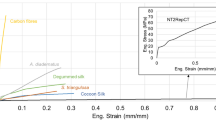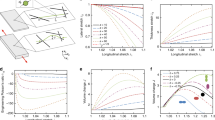Abstract
W. F. THOMAS recently pointed out1 that E glass fibres in the size range 0.0002–0.0006 in. had a very consistent strength of 540,000 lb./in.2, when tested on a 1-in. gauge length. This is equivalent to an elastic failing strain of about 5 per cent. Other workers have found the strength of untouched glass fibres drawn in a similar way to be lower and more variable, depending on the conditions under which the fibres were formed2 3.
This is a preview of subscription content, access via your institution
Access options
Subscribe to this journal
Receive 51 print issues and online access
$199.00 per year
only $3.90 per issue
Buy this article
- Purchase on Springer Link
- Instant access to full article PDF
Prices may be subject to local taxes which are calculated during checkout
Similar content being viewed by others
References
Thomas, W. F., Nature, 181, 1006 (1958).
Griffith, A. A., Trans. Roy. Soc., A, 221, 163 (1920).
Otto, W. H., J. Amer. Ceram. Soc., 38 (3), 122 (1955).
Author information
Authors and Affiliations
Rights and permissions
About this article
Cite this article
PARRATT, N. Strength of Glass Fibres. Nature 181, 1726–1727 (1958). https://doi.org/10.1038/1811726c0
Issue Date:
DOI: https://doi.org/10.1038/1811726c0
Comments
By submitting a comment you agree to abide by our Terms and Community Guidelines. If you find something abusive or that does not comply with our terms or guidelines please flag it as inappropriate.



